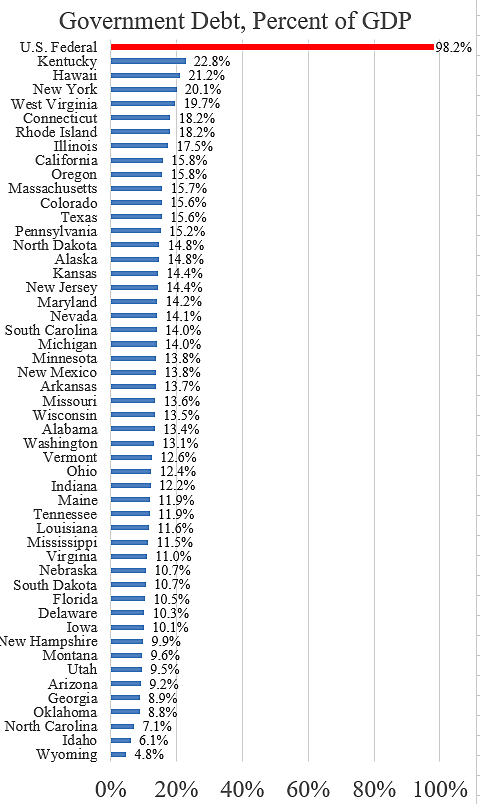The federal government’s debt is massive and growing rapidly. How massive? Federal debt held by the public of $28.5 trillion is eight times larger than the combined debt of all state and local governments of $3.3 trillion.
Not only is state and local debt much smaller, but the states have more justification for accumulating debt than the federal government. That is because a larger share of state‐local spending is for capital investment, which is partly financed by debt. State‐local debt is matched by large holdings of return‐producing assets such as highways.
By contrast, federal debt generally funds consumption—such as entitlement programs—not capital investment. And while federal borrowing during crises and recessions is reasonable, the debt should be paid back when the economy is growing.
The chart below compares federal debt as a percent of U.S. gross domestic product to the state‐local debt of each state as a percent of state GDP. Federal debt of 98 percent in 2023 compares to the simple average of state‐local debt of 13 percent. (The state ratios are from Census data for 2021, but total state‐local debt has changed little since then).
Also consider that most state‐local debt consists of “revenue bonds,” which will be paid back from revenues for facilities such as utilities, colleges, and hospitals. “General obligation” bonds backed by taxes account for a minority of state‐local debt. Thus, not only is state‐local debt just 13 percent the size of federal debt, but less than half of it will be paid back by taxes.
For these reasons, federal debt is a far larger threat to taxpayers, young people, and the economy than state‐local debt. Whether for reasons of political culture or lack of constitutional or statutory rules, federal policymakers have been much more fiscally irresponsible than their state‐local peers.
That said, there is substantial variation between the states. States such as Wyoming, Idaho, and North Carolina show that modern governments can be run using very little debt. Policymakers in Kentucky, Hawaii, and New York could learn fiscal lessons from these low‐debt states—and so should the federal government.

Note: I have argued that state and local governments should keep debt to an absolute minimum. They should use taxes or other current charges to fund infrastructure, or they should privatize it. Krit Chanwong contributed to this post.
Themes: